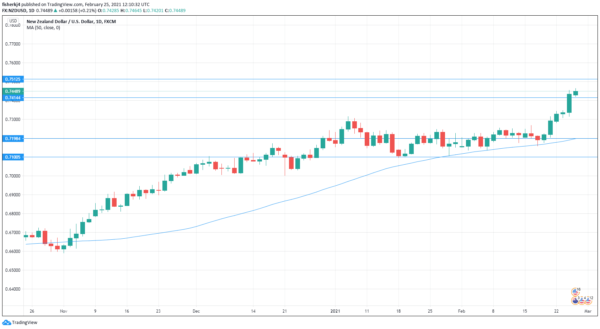The New Zealand dollar has posted modest gains in the Thursday session. Currently, NZD/USD is trading at 0.7445, up 0.16% on the day.
New Zealand dollar soars
The New Zealand dollar exploded on Wednesday, rising 1.3 per cent. The currency shot up after Finance Minister Grant Robertson announced that the central bank (RBNZ) would be required to take into consideration government policies in its monetary policy decisions. The government has inserted a new clause in the RBNZ’s Monetary Policy Committee, which says that government policy is to “support more sustainable house prices” and “dampening investor demand for existing housing stock”. RBZN Governor strongly opposed this move last year, but it appears that the government’s concern over the housing bubble has led it to make this move. The central bank will now be required to take the housing market into account as one of the factors which goes into monetary policy.
The markets took this as a sign that that the RBNZ could raise rates in order to cool the red-hot housing market, and higher rates would make the New Zealand dollar more attractive to investors. This triggered sharp gains for NZD/USD, which crossed into 74 territory for the first time since February 2018.
Overshadowed by the government’s move was a strong release from ANZ Business Confidence for February. Although Business Confidence slowed from 9.4 to 7.0, it was only the second gain after three years of consecutive declines. The newfound optimism in economic conditions reflects the economy’s strong recovery from the Covid pandemic.
Over in the US, we’ll get a look at second-estimate GDP for Q4 as well as Durable Goods. GDP is projected to be upwardly revised from 4.0% to 4.2%. Headline Durable Goods is expected to jump from 0.2% to 0.9%, while the core reading is forecast to tick lower to 0.7%, from 0.7% beforehand.
NZD/USD Technical
- NZD/USD has broken above resistance at 0.7414. The next resistance line is at 0.7512, which has held since August 2017.
- There is support at 0.7198. The 50-day moving average (MA) is also situated at this line. Below, we find support at 0.7100














